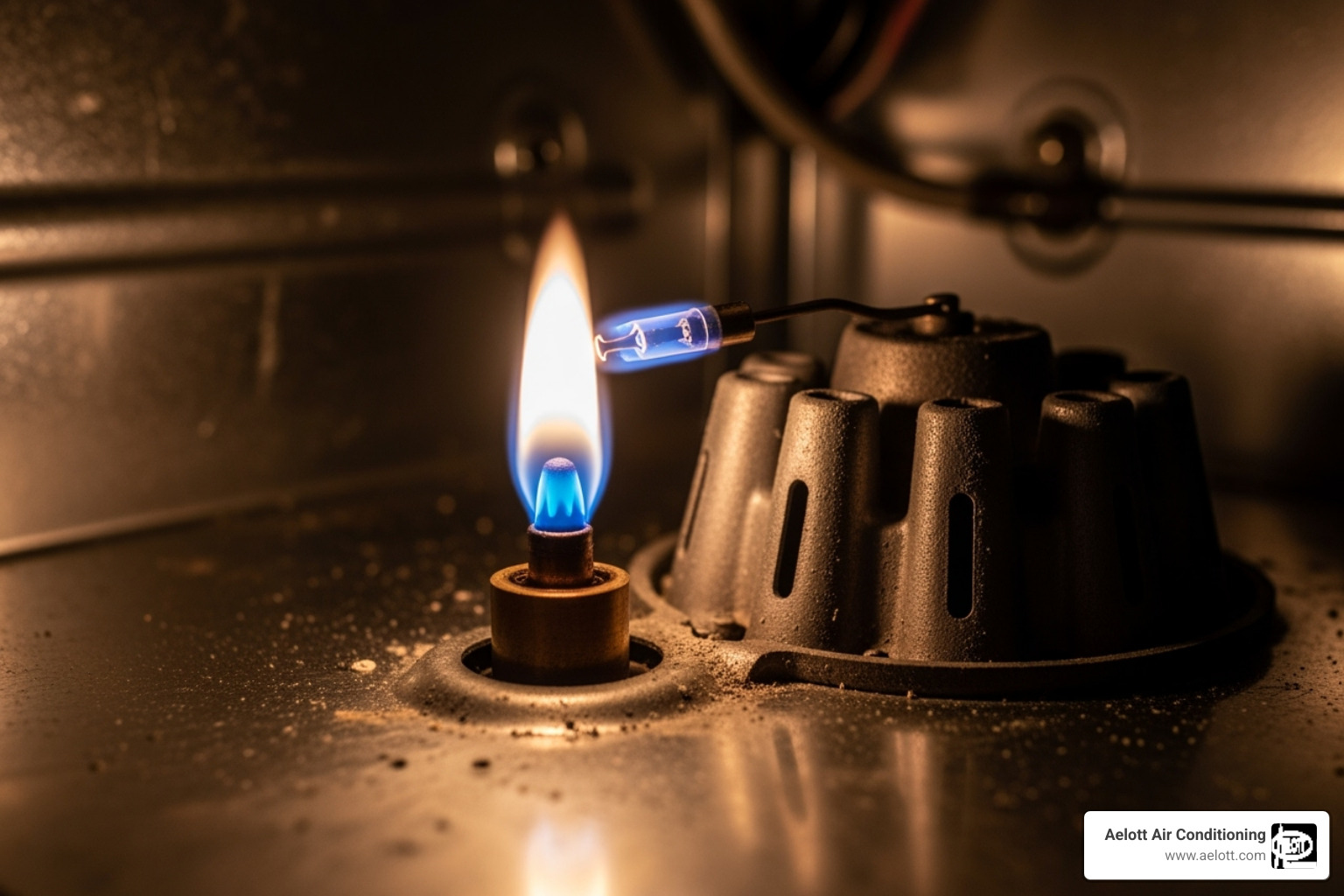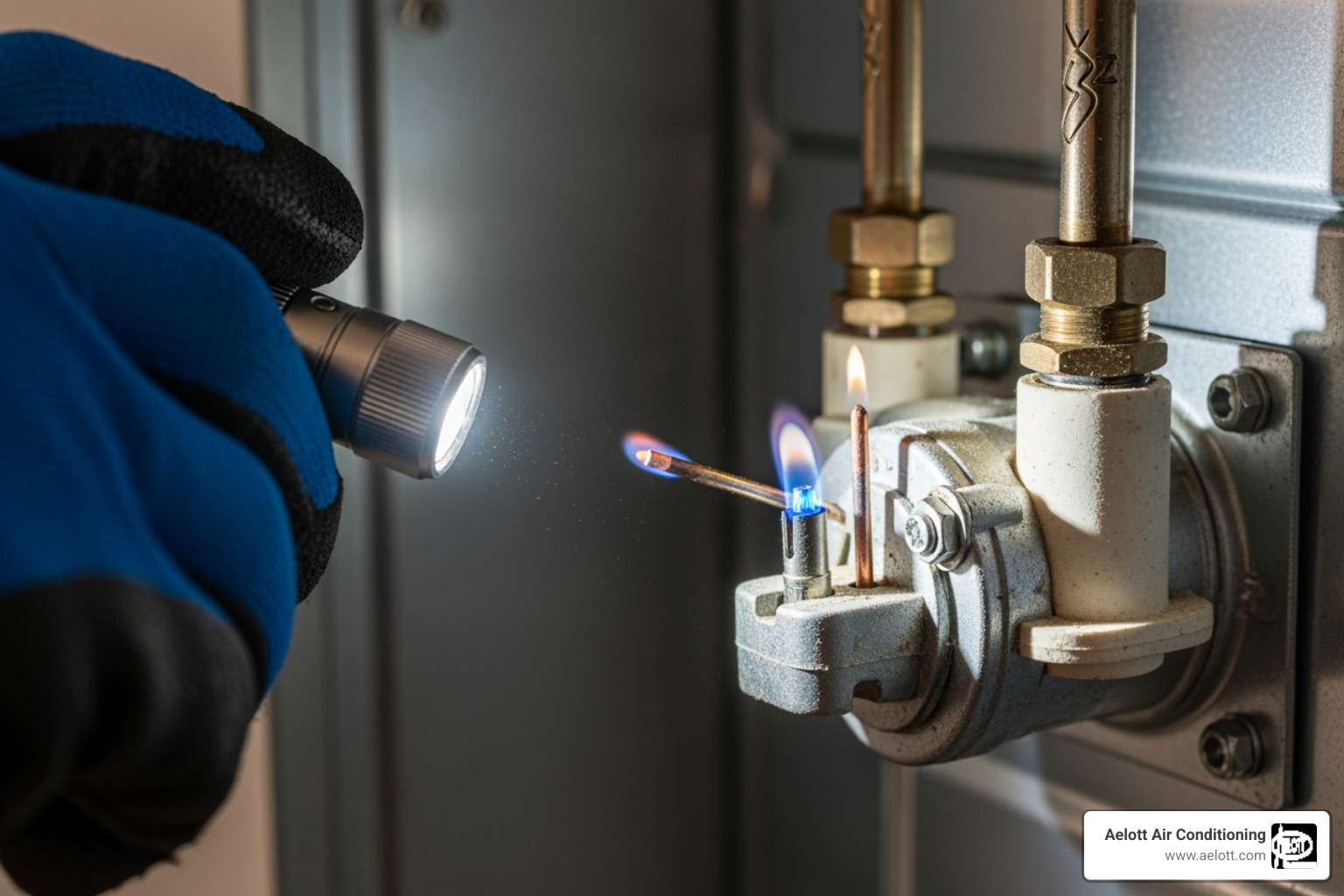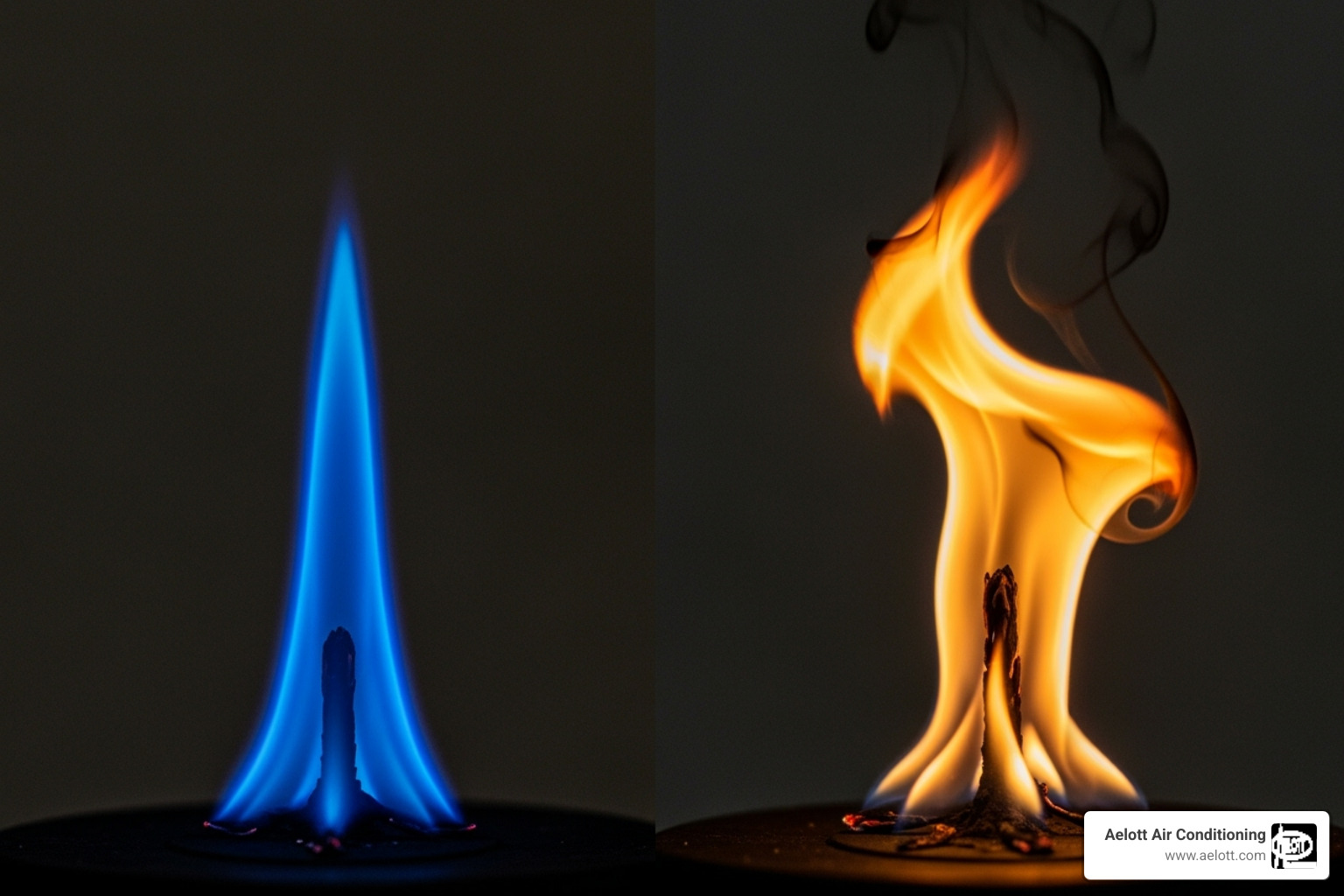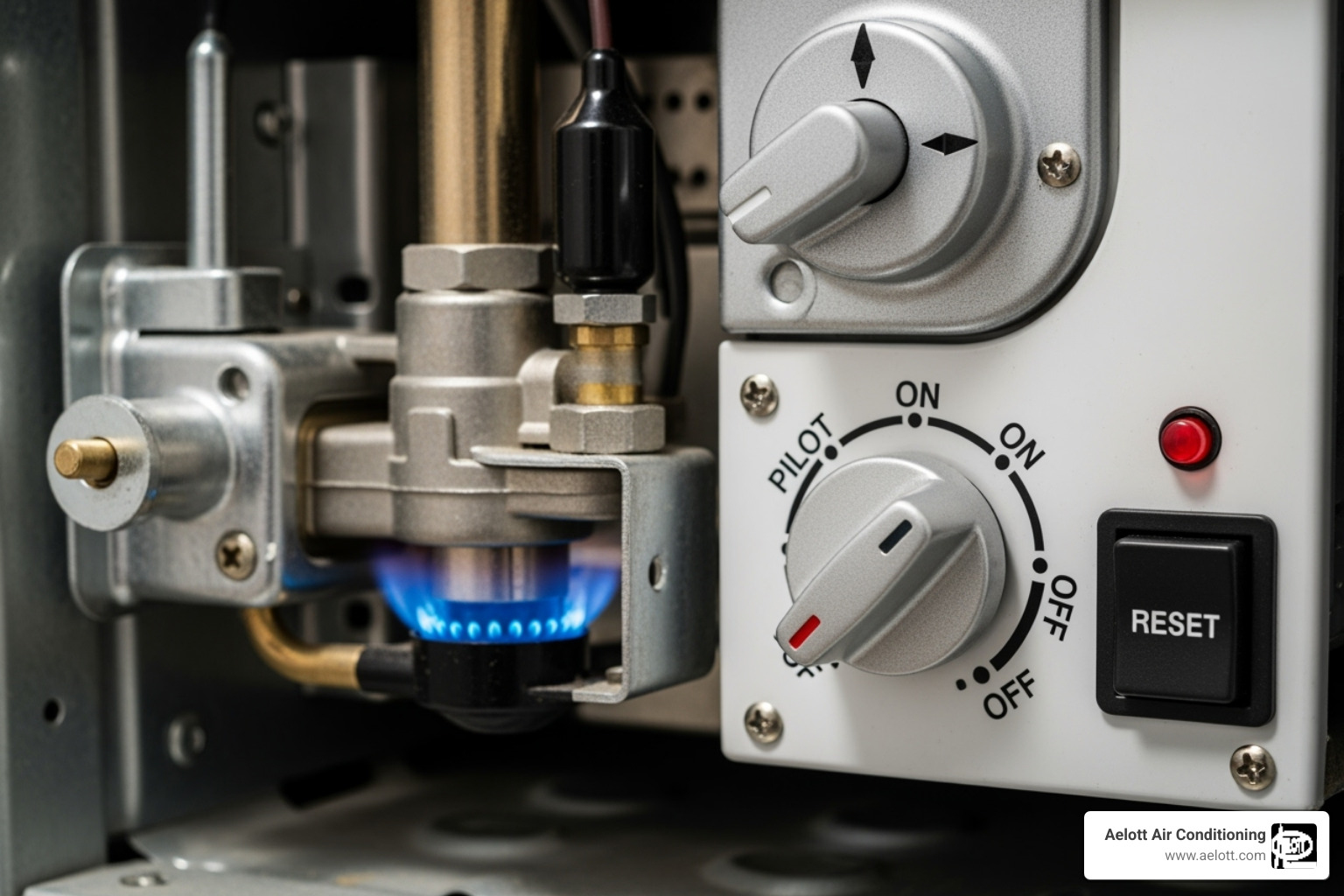.webp)
.webp)
The Secret Spark: Finding and Fixing Your Furnace Pilot Light
Troubleshoot & safely relight your furnace pilot light. Our guide covers common issues, DIY steps, and when to call a pro.

Why Your Furnace Pilot Light Matters
A furnace pilot light is a small, constant flame that ignites your furnace's main burners. When this flame goes out, your furnace won't produce heat, leaving you in the cold.
Quick Answer: How to Relight Your Furnace Pilot Light
- Turn off the thermostat and gas control knob to "OFF"
- Wait 5 minutes for gas to dissipate.
- Turn knob to "PILOT" and press the reset button.
- Light the pilot with a long lighter while holding the reset button.
- Hold for 30-60 seconds until the thermocouple heats up.
- Release button - the pilot should stay lit.
- Turn knob to "ON" and restore power to your furnace.
If your pilot light keeps going out, you might have a bigger problem that needs professional attention. Many North County San Diego homeowners face this issue each winter.
The good news is that most pilot light problems are fixable. Whether it's a dirty thermocouple, a clogged pilot orifice, or a simple draft, understanding your pilot light system helps you regain control of your home's comfort.
However, safety first is crucial. Gas appliances require careful handling, and knowing when to DIY versus when to call a professional can save you money and keep your family safe.

Understanding Your Furnace's Ignition System
Not all furnaces work the same way, and understanding your system can save you time and money.
If your furnace is over 20 years old, it likely has a standing pilot light. This is a small blue flame that burns 24/7. Furnaces facilitate the combustion process with a pilot light by using this constant flame to ignite the main burners when your thermostat calls for heat.

Newer furnaces, especially those made after 2010, typically use electronic ignition systems instead of a traditional pilot light. These systems are more energy-efficient and safer.
These newer systems come in two main types. Hot surface igniters use an electrically heated element to light the gas. Intermittent pilot systems use an electronic spark to light a pilot flame only when heat is needed. These modern units have high AFUE ratings (94% to 98.5%), a significant improvement over older models with a constantly burning furnace pilot light.
What is a Thermocouple and How Does It Work?
If your furnace has a standing pilot light, it also has a thermocouple. This metal rod is a critical safety device.
The thermocouple sits in the pilot light flame and senses its heat. When the flame is lit, the thermocouple generates a small amount of voltage, which signals the gas valve to stay open.
If the pilot light goes out, the thermocouple cools down and stops producing voltage. This causes the gas valve to shut, cutting off the gas supply and preventing dangerous leaks. If your furnace pilot light won't stay lit, a malfunctioning thermocouple is often the cause, as it's designed to shut the system down when it detects a problem.
Troubleshooting: Why Your Pilot Light Won't Stay Lit
It's frustrating when your furnace pilot light won't stay lit. While a simple relight can work, a persistent problem usually points to an underlying issue.

Common problems that cause a furnace pilot light to go out include:
- Drafts: A strong gust of air can blow out the flame.
- Dirty Pilot Orifice: A clogged opening can starve the flame of fuel.
- Gas Supply Issues: Low gas pressure can lead to a weak or extinguished flame.
- Wear and Tear: Components wear out over time.
Understanding these common culprits is the first step toward a warm home.
Common Reasons Your Furnace Pilot Light Goes Out
If your furnace pilot light keeps going out, it's signaling an issue. Here are the most frequent reasons, especially in older gas furnaces:
- Faulty Thermocouple: As a safety device, a dirty, bent, or worn-out thermocouple won't generate enough voltage to keep the gas valve open. This is the most common reason a pilot light won't stay lit.
- Clogged Pilot Orifice: The pilot orifice is a tiny opening that delivers gas to the pilot light. Dirt, dust, or corrosion can block it, leading to a weak, flickering flame that extinguishes easily.
- Gas Valve Issues: A malfunctioning gas valve might not supply enough gas pressure to keep the flame burning steadily.
- Drafts or Airflow Disruptions: A strong gust of air from a window, leaky duct, or damaged vent pipe can extinguish the pilot light. A cracked heat exchanger, a more serious issue, can also create air pressure changes that blow out the flame.
- Malfunctioning Gas Pressure Regulator: A faulty regulator can cause inconsistent gas flow to your furnace, causing the pilot light to go out.
- Utility Disruptions: A temporary reduction in gas supply from your utility company can extinguish your pilot light.
Pilot light problems are most common in older gas furnaces where components have aged.
What to Do If Your Furnace Pilot Light Flame Looks Wrong
The appearance of your furnace pilot light flame reveals its health.

- The Healthy Flame: A proper pilot light is a steady, robust blue flame, sometimes with a yellow tip. This indicates efficient combustion and sufficient heat for the thermocouple.
- Weak or Flickering Flame: A weak or flickering flame suggests impeded gas flow or airflow, often from dirt in the pilot tube or orifice. This restricts fuel or oxygen, making the flame unstable.
- Yellow or Orange Flame: This is a critical warning sign of incomplete combustion, usually from a dirty air intake. This type of flame produces dangerous carbon monoxide and isn't hot enough to operate the furnace efficiently or safely. If you see a yellow or orange flame, it requires immediate attention.
For weak flames, you might try carefully cleaning the pilot orifice. For yellow or orange flames, we strongly recommend professional service to ensure safety and proper combustion.
How to Safely Relight Your Furnace Pilot Light: A Step-by-Step Guide
Relighting your furnace pilot light might seem intimidating at first, but it's actually something most homeowners can handle safely. Think of it like lighting a gas grill – with the right precautions and a steady hand, you'll have your home toasty again in no time.
Here's what you'll need before we start: your furnace's owner's manual (trust us, it's your best friend here), a long-reach lighter or long matches, and a flashlight for better visibility.
Now, let's talk safety – because working with natural gas requires respect and careful attention to detail.
Turn off your thermostat completely or set it to the lowest temperature. This prevents your furnace from trying to fire up while you're working on it. Next, take a moment to smell for gas around your furnace area. If you detect even the faintest whiff of that distinctive rotten egg smell, stop immediately. Don't flip any switches, don't light anything – just get everyone out of the house, leave the door open, and call your gas company from outside.
Ensure proper ventilation by opening nearby windows and doors. This helps any lingering gas dissipate safely. Turn off the power to your furnace using the wall switch (it usually looks like a regular light switch) or flip the circuit breaker.
Here's the most important part: wait a full five minutes. We know it's tempting to rush when you're cold, but this waiting period lets any accumulated gas clear out completely. Use this time to review the steps ahead – patience now prevents problems later.
Step 1: Locate the Pilot Assembly and Gas Valve
Time for a little treasure hunt! Your pilot light assembly is typically hiding near the bottom of your furnace. You might spot it through a small viewing window, or you may need to remove a small access panel – usually just a matter of unclipping or unscrewing a cover.

Once you've found your target, get familiar with the control knob – it's your command center. You'll see three positions clearly marked: "Off," "Pilot," and "On." There's also a reset button nearby, usually red or black, that you'll need to press during the lighting process.
Take a moment to locate these components with your flashlight. Knowing exactly where everything is before you start makes the whole process smoother.
Step 2: Turn Off Gas and Wait
Safety first means starting with everything completely shut down. Turn that control knob all the way to "OFF" – this cuts off the gas supply to both your pilot light and main burners.
Now comes the hardest part for cold homeowners: waiting five full minutes. Yes, we know your house feels like an icebox, but this step is absolutely non-negotiable. Any gas that might have built up in your furnace needs time to dissipate completely.
Think of it as giving your furnace a clean slate. Grab a cup of coffee, check your phone, or review these steps one more time. Those five minutes are your insurance policy against any fire hazards.
Step 3: Light the Pilot
Here's where the magic happens! Turn your control knob from "OFF" to "PILOT" – you should hear a soft hissing sound as gas begins flowing to the pilot.
Press and hold that reset button firmly while you bring your long lighter or match to the pilot light opening. The flame should catch right away – and when it does, keep holding that reset button!
This next part is crucial: hold the reset button for a full 30 to 60 seconds after the pilot lights. We can't stress this enough – your thermocouple needs this time to heat up properly. If you let go too early, you'll watch that little flame die out, and you'll be starting over.
Don't worry if it takes a couple tries. Sometimes thermocouples are a bit stubborn, especially if they've been cold for a while. Just repeat the process, making sure to hold that button long enough each time.
Step 4: Turn the Furnace On
You're in the home stretch! Once your pilot light stays lit after you release the reset button, turn the control knob from "PILOT" to "ON."
Restore power to your furnace by flipping that wall switch and circuit breaker back on. Head back to your thermostat and set it to your desired temperature – make sure it's higher than your current room temperature so your furnace knows you want heat.
Once the pilot light is burning steadily, you should hear your main burners kick in within a few minutes. Soon, you'll feel that wonderful warm air flowing from your vents again.
If your main burners don't fire up, or if your pilot light goes out again, don't keep trying. That's your furnace telling you it needs professional attention, and we're here to help when that happens.
DIY vs. Calling a Pro: When to Seek Expert Help
Empowering homeowners with knowledge is important, but so is knowing when to call in professionals. While relighting a furnace pilot light is often a straightforward DIY task, some situations require expert attention.
If your pilot light went out after a power outage and relights easily, you can likely handle it yourself. But if you find yourself frequently relighting a stubborn flame, something deeper is going on.
Simple DIY situations include a pilot light that goes out after a power outage or gas interruption and relights easily. If you're comfortable with basic maintenance and the pilot flame clears up to a healthy blue color after gentle cleaning, that's often manageable too.
Professional help is needed when your pilot light repeatedly goes out, won't stay lit after holding the reset button for a full minute, or when you detect any gas smell. A consistently yellow or orange flame, strange noises, or frequent issues with a furnace over 15-20 years old are also clear signals to call the experts.
Signs You Need Professional Furnace Repair
Your furnace pilot light often acts as an early warning system. Ignoring recurring pilot light issues can lead to more expensive repairs later.
The most obvious red flag is a pilot light that won't cooperate. If you've followed the relighting steps and the flame still dies when you release the reset button, you're likely dealing with a faulty thermocouple, gas valve problem, or a pilot orifice that's too clogged for DIY cleaning.
A persistent yellow or orange flame is a serious safety concern that demands immediate professional attention. This color indicates incomplete combustion, which can produce dangerous carbon monoxide. A flame that stays yellow signals deeper issues that require expert diagnosis.
Any gas smell is an immediate emergency. Do not try to relight your pilot light. Turn off your gas supply, evacuate the house, and call your gas company and an HVAC professional from a safe location. This could indicate a gas leak, broken valve, or cracked heat exchanger.
Strange sounds like grinding, squealing, or banging usually indicate mechanical problems beyond the pilot light. Similarly, if your pilot light stays lit but the main burner won't ignite, or the furnace blows cold air, you're looking at more complex system problems.
When these situations arise, seek professional Furnace Repair. You can also learn about The Top Signs Your Furnace Needs Maintenance to catch problems early.
Preventive Maintenance and When to Consider Replacement
The best way to avoid furnace pilot light problems is through consistent preventive care. A little attention now saves a lot of headaches later.
Annual professional tune-ups are essential. During these visits, we clean components, check gas pressure, inspect your pilot light assembly and thermocouple, and catch potential problems before they become emergencies.
You can help between visits by changing your air filter regularly and keeping the area around your furnace clean. If drafts blow out your pilot light, seal gaps around nearby windows or doors.
Even well-maintained furnaces don't last forever. Gas furnaces typically last 15 to 20 years. If your system is approaching this age and you're constantly dealing with pilot light problems, it might be time to consider replacement.
Signs pointing toward replacement include frequent service calls, rising energy bills, uneven heating, and strange noises. While a new furnace is an investment, the long-term savings on energy and repairs often make it a smart financial decision.
Our Furnace Maintenance Services can help maximize your current system's lifespan. When it's time for a new unit, we're here to guide you through Furnace Replacement options.
Frequently Asked Questions about Furnace Pilot Lights
We often get questions from homeowners about their furnace pilot light. Here are answers to the most common ones.
How do I know if my furnace has a pilot light?
This depends on your furnace's age. If it was made before 2010 or is over 20 years old, it likely has a standing pilot light. Look for a small, steady blue flame burning continuously, usually through an access panel at the bottom.
Newer furnaces typically have an electronic ignition system and no constant flame. These use a hot surface igniter or an intermittent pilot that only fires up when heat is needed. Your furnace manual will specify which type of ignition you have.
Is it dangerous to relight a pilot light myself?
Relighting your furnace pilot light is generally safe if you follow the proper steps carefully. The key safety measures are turning off the gas, waiting five minutes for any gas to clear, and ensuring good ventilation.
However, you should always call a professional if you smell gas, feel uncertain about the process, or if the pilot light keeps going out. Your safety is more important than saving on a service call.
How much does it cost to fix a pilot light issue?
The cost of pilot light repairs varies depending on the cause. Cleaning a dirty pilot orifice is a minor fix, while replacing a faulty thermocouple is a common and moderately priced repair.
Costs can increase if the issue involves the main gas valve or other major components. If you have frequent pilot light problems with an older furnace, it might be more cost-effective to upgrade to a newer, more efficient system. We provide honest advice on whether a repair or replacement makes more financial sense.
Stay Warm and Safe with Expert Help
When your furnace pilot light decides to take an unexpected vacation, it can transform your comfortable home into an arctic trip faster than you'd like. While we've walked you through the steps to safely relight it yourself, there's real wisdom in knowing when to wave the white flag and call in the cavalry.
That's where we come in. Here at Aelott Air Conditioning, we've been keeping North County San Diego families warm and comfortable since 1963. That's over six decades of experience dealing with stubborn furnace pilot lights, temperamental thermocouples, and every heating challenge you can imagine. We've seen it all, fixed it all, and we're still here because we believe in doing things the right way.
Our approach is refreshingly straightforward: honest service, fair pricing, and a 100% satisfaction guarantee. No surprises, no run-around, no trying to sell you something you don't need. When your pilot light keeps going out despite your best DIY efforts, or when you smell gas and need immediate help, we respond with the urgency and expertise your situation demands.
We understand that heating problems never happen at convenient times. That's why our team is ready to help homeowners throughout Escondido, Carmel Mountain, Del Mar, Bonsall, Encinitas, Vista, Oceanside, Carlsbad, San Marcos, Poway, Kearny Mesa, Valley Center, Solana Beach, Rancho Santa Fe, Rancho Bernardo, Ramona, Miramar, La Jolla, Fallbrook, and all of North County San Diego and San Diego County, California.
Don't let a finicky furnace pilot light turn your home into an icebox. Whether you need a quick thermocouple replacement, a thorough system cleaning, or help deciding if it's time for a furnace upgrade, we're here to keep you safe and comfortable. Contact us today for reliable Heating Repair and experience the peace of mind that comes with decades of trusted service.

Customer Testimonials
Go With Experience

HVAC Financing Available!
Get 0% Financing for 12 Months with Deferred Interest! Enjoy no payments and no interest on select plans.


Latest Blogs

.avif)
How to Run Your Furnace Efficiently: A Guide to Staying Warm This Winter







